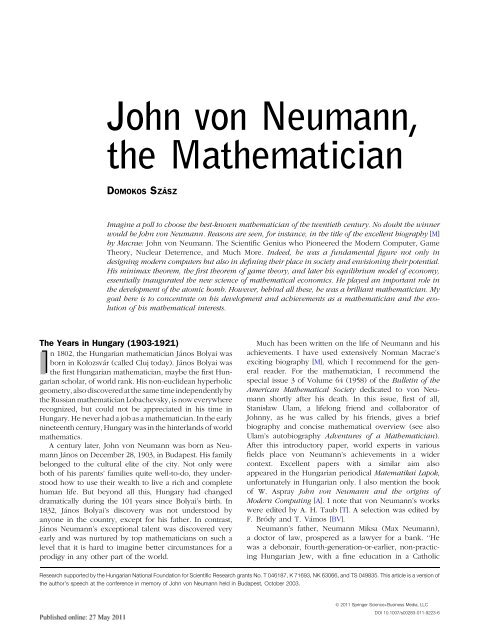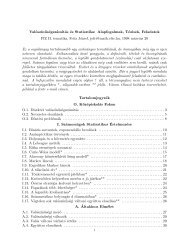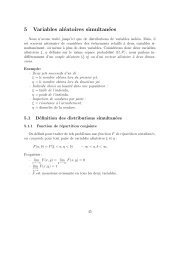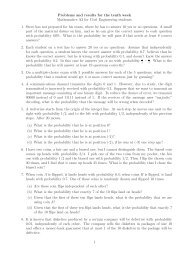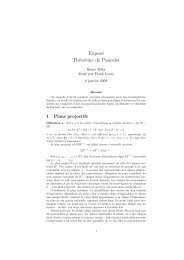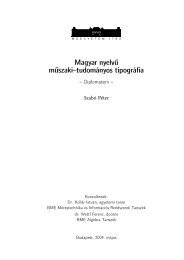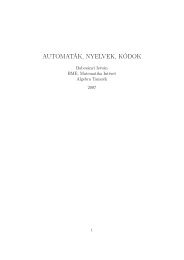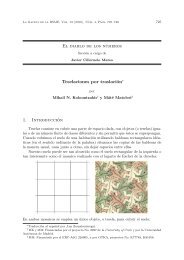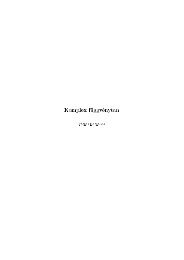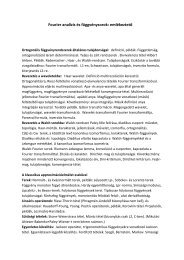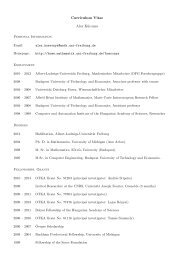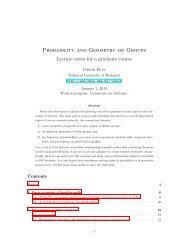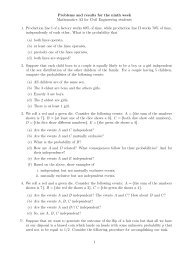John von Neumann, the Mathematician
John von Neumann, the Mathematician
John von Neumann, the Mathematician
You also want an ePaper? Increase the reach of your titles
YUMPU automatically turns print PDFs into web optimized ePapers that Google loves.
<strong>John</strong> <strong>von</strong> <strong>Neumann</strong>,<br />
<strong>the</strong> Ma<strong>the</strong>matician<br />
DOMOKOS SZÁSZ<br />
Imagine a poll to choose <strong>the</strong> best-known ma<strong>the</strong>matician of <strong>the</strong> twentieth century. No doubt <strong>the</strong> winner<br />
would be <strong>John</strong> <strong>von</strong> <strong>Neumann</strong>. Reasons are seen, for instance, in <strong>the</strong> title of <strong>the</strong> excellent biography [M]<br />
by Macrae: <strong>John</strong> <strong>von</strong> <strong>Neumann</strong>. The Scientific Genius who Pioneered <strong>the</strong> Modern Computer, Game<br />
Theory, Nuclear Deterrence, and Much More. Indeed, he was a fundamental figure not only in<br />
designing modern computers but also in defining <strong>the</strong>ir place in society and envisioning <strong>the</strong>ir potential.<br />
His minimax <strong>the</strong>orem, <strong>the</strong> first <strong>the</strong>orem of game <strong>the</strong>ory, and later his equilibrium model of economy,<br />
essentially inaugurated <strong>the</strong> new science of ma<strong>the</strong>matical economics. He played an important role in<br />
<strong>the</strong> development of <strong>the</strong> atomic bomb. However, behind all <strong>the</strong>se, he was a brilliant ma<strong>the</strong>matician. My<br />
goal here is to concentrate on his development and achievements as a ma<strong>the</strong>matician and <strong>the</strong> evolution<br />
of his ma<strong>the</strong>matical interests.<br />
The Years in Hungary (1903-1921)<br />
In 1802, <strong>the</strong> Hungarian ma<strong>the</strong>matician János Bolyai was<br />
born in Kolozsvár (called Cluj today). János Bolyai was<br />
<strong>the</strong> first Hungarian ma<strong>the</strong>matician, maybe <strong>the</strong> first Hungarian<br />
scholar, of world rank. His non-euclidean hyperbolic<br />
geometry, also discovered at <strong>the</strong> same time independently by<br />
<strong>the</strong> Russian ma<strong>the</strong>matician Lobachevsky, is now everywhere<br />
recognized, but could not be appreciated in his time in<br />
Hungary. He never had a job as a ma<strong>the</strong>matician. In <strong>the</strong> early<br />
nineteenth century, Hungary was in <strong>the</strong> hinterlands of world<br />
ma<strong>the</strong>matics.<br />
A century later, <strong>John</strong> <strong>von</strong> <strong>Neumann</strong> was born as <strong>Neumann</strong><br />
János on December 28, 1903, in Budapest. His family<br />
belonged to <strong>the</strong> cultural elite of <strong>the</strong> city. Not only were<br />
both of his parents’ families quite well-to-do, <strong>the</strong>y understood<br />
how to use <strong>the</strong>ir wealth to live a rich and complete<br />
human life. But beyond all this, Hungary had changed<br />
dramatically during <strong>the</strong> 101 years since Bolyai’s birth. In<br />
1832, János Bolyai’s discovery was not understood by<br />
anyone in <strong>the</strong> country, except for his fa<strong>the</strong>r. In contrast,<br />
János <strong>Neumann</strong>’s exceptional talent was discovered very<br />
early and was nurtured by top ma<strong>the</strong>maticians on such a<br />
level that it is hard to imagine better circumstances for a<br />
prodigy in any o<strong>the</strong>r part of <strong>the</strong> world.<br />
Much has been written on <strong>the</strong> life of <strong>Neumann</strong> and his<br />
achievements. I have used extensively Norman Macrae’s<br />
exciting biography [M], which I recommend for <strong>the</strong> general<br />
reader. For <strong>the</strong> ma<strong>the</strong>matician, I recommend <strong>the</strong><br />
special issue 3 of Volume 64 (1958) of <strong>the</strong> Bulletin of <strong>the</strong><br />
American Ma<strong>the</strong>matical Society dedicated to <strong>von</strong> <strong>Neumann</strong><br />
shortly after his death. In this issue, first of all,<br />
Stanisław Ulam, a lifelong friend and collaborator of<br />
<strong>John</strong>ny, as he was called by his friends, gives a brief<br />
biography and concise ma<strong>the</strong>matical overview (see also<br />
Ulam’s autobiography Adventures of a Ma<strong>the</strong>matician).<br />
After this introductory paper, world experts in various<br />
fields place <strong>von</strong> <strong>Neumann</strong>’s achievements in a wider<br />
context. Excellent papers with a similar aim also<br />
appeared in <strong>the</strong> Hungarian periodical Matematikai Lapok,<br />
unfortunately in Hungarian only. I also mention <strong>the</strong> book<br />
of W. Aspray <strong>John</strong> <strong>von</strong> <strong>Neumann</strong> and <strong>the</strong> origins of<br />
Modern Computing [A]. I note that <strong>von</strong> <strong>Neumann</strong>’s works<br />
were edited by A. H. Taub [T]. A selection was edited by<br />
F. Bródy and T. Vámos [BV].<br />
<strong>Neumann</strong>’s fa<strong>the</strong>r, <strong>Neumann</strong> Miksa (Max <strong>Neumann</strong>),<br />
a doctor of law, prospered as a lawyer for a bank. ‘‘He<br />
was a debonair, fourth-generation-or-earlier, non-practicing<br />
Hungarian Jew, with a fine education in a Catholic<br />
Research supported by <strong>the</strong> Hungarian National Foundation for Scientific Research grants No. T 046187, K 71693, NK 63066, and TS 049835. This article is a version of<br />
<strong>the</strong> author’s speech at <strong>the</strong> conference in memory of <strong>John</strong> <strong>von</strong> <strong>Neumann</strong> held in Budapest, October 2003.<br />
Ó 2011 Springer Science+Business Media, LLC<br />
DOI 10.1007/s00283-011-9223-6
provincial high-school. He was well attuned to fin-de-siècle<br />
Austria-Hungary and indeed to being a lively intellectual in<br />
any age. His party piece was to compose two-line ditties<br />
about <strong>the</strong> latest vicissitudes of his personal or business life,<br />
and about national and international politics.’’ 1 Jacob Kann,<br />
<strong>Neumann</strong>’s grandfa<strong>the</strong>r through his mo<strong>the</strong>r Kann Margit<br />
(Margaret Kann), ‘‘was a distinctly prosperous man. With a<br />
partner, he had built up in Budapest a thriving business in<br />
agricultural equipment that grew even faster in 1880-1914<br />
than Hungary’s <strong>the</strong>n soaring GNP.’’ The Kanns owned a<br />
ra<strong>the</strong>r big and nice house close to <strong>the</strong> Hungarian Parliament<br />
on <strong>the</strong> so-called Kiskörút, Small Boulevard. The<br />
Kanns and later <strong>the</strong> families of <strong>the</strong>ir four daughters lived<br />
<strong>the</strong>re, while <strong>the</strong> ground floor was occupied by <strong>the</strong> firm<br />
Kann-Heller. When <strong>the</strong> families grew larger, <strong>the</strong>y also<br />
rented <strong>the</strong> neighboring house. János’s mo<strong>the</strong>r Margit was<br />
‘‘a mo<strong>the</strong>r hen tending her children and protecting <strong>the</strong>m.<br />
She was a family woman, a good deal less rigorous than her<br />
husband, artistically inclined, a wafer-thin and later chainsmoking<br />
enthusiast for comporting oneself with what she<br />
called ‘elegance’ (which later became <strong>Neumann</strong>’s highest<br />
term of praise for neat ma<strong>the</strong>matical calculations such as<br />
<strong>the</strong> ones that made <strong>the</strong> H-bomb possible).’’<br />
Max and Margaret had three children, of which <strong>John</strong>ny<br />
was <strong>the</strong> oldest. ‘‘Grandfa<strong>the</strong>r Jacob Kann had gone straight<br />
.........................................................................<br />
AUTHOR<br />
DOMOKOS SZÁSZ is a student of A.<br />
Prékopa, A. Rényi, B. V. Gnedenko, and Ya.<br />
G. Sinai. He founded <strong>the</strong> Budapest schools in<br />
ma<strong>the</strong>matical statistical physics and dynamical<br />
systems. His current ambition is <strong>the</strong> rigorous<br />
derivation of laws of statistical physics<br />
(diffusion, heat conduction) from microscopic<br />
assumptions. His o<strong>the</strong>r enthusiasms are his<br />
family (three children, two grandchildren),<br />
culture, and skiing.<br />
Ma<strong>the</strong>matical Institute<br />
Budapest University of Technology and<br />
Economics<br />
H-1111 Budapest<br />
Hungary<br />
from commercial high school into founding his business,<br />
but he proved demonic in his capacity for arithmetic<br />
manipulation. He could add in his head monstrous columns<br />
of numbers or multiply mentally two numbers in <strong>the</strong><br />
thousands or even millions. The six-year-old <strong>John</strong>ny would<br />
laboriously perform <strong>the</strong> computations with pencil and<br />
paper, and announce with glee that Grandfa<strong>the</strong>r had been<br />
absolutely on <strong>the</strong> mark. Later <strong>John</strong>ny himself was known<br />
for his facility in mental computation, but he had long<br />
before persuaded himself that he could never match<br />
Jacob’s level of multiplication skill.’’<br />
‘‘Nursemaids, governesses and preschool teachers were<br />
an integral part of upper-middle-class European households<br />
in those days, especially in countries where (as in<br />
Hungary) children in such families did not start school until<br />
age ten. As <strong>the</strong> Kann grandchildren and some of <strong>John</strong>ny’s<br />
second cousins came along, <strong>the</strong> building on <strong>the</strong> Small<br />
Boulevard became an educational institution in its own<br />
right. There was an especially early emphasis on learning<br />
foreign languages. Fa<strong>the</strong>r Max thought that youngsters who<br />
spoke only Hungarian would not merely fail in <strong>the</strong> Central<br />
Europe <strong>the</strong>n darkening around <strong>the</strong>m, <strong>the</strong>y might not even<br />
survive.’’ So <strong>John</strong>ny (or Jancsi in Hungarian) learned German,<br />
French, English, and Italian from various governesses<br />
from abroad. <strong>John</strong>ny later told colleagues in Princeton that<br />
as a six-year-old he would converse with his fa<strong>the</strong>r in<br />
classical Greek. This seems to have been a joke, but his<br />
knowledge of languages was real. It not only made his<br />
communication easier in Germany, Zürich, and in <strong>the</strong> US,<br />
but it may have imprinted at an early age axiomatic and<br />
abstract, algorithmic thinking into his brain.<br />
In such an environment, young <strong>John</strong>ny was easily<br />
drinking in <strong>the</strong> knowledge surrounding him. One of his<br />
special interests was history: The family bought ‘‘an entire<br />
library, whose centerpiece was <strong>the</strong> Allgemeine Geschichte<br />
by Wilhelm Oncken. <strong>John</strong>ny ploughed through all fortyfour<br />
volumes. Bro<strong>the</strong>r Michael was confounded by <strong>the</strong> fact<br />
that what <strong>John</strong>ny read, <strong>John</strong>ny remembered. Decades later<br />
friends were startled to discover that he remembered still.’’<br />
Between 1914 and 1921, <strong>John</strong>ny attended <strong>the</strong> Lu<strong>the</strong>ran<br />
Gymnasium in Budapest. Here, too, he received a superb<br />
education. This was made possible by <strong>the</strong> fast economic<br />
and social progress after <strong>the</strong> compromise with Austria 2 and<br />
subsequent cultural and educational reforms. 3<br />
1 Here and below, many unattributed quotes are from [M].<br />
2 Some data from <strong>the</strong> late nineteenth-century history of Hungary. 1867: Appeasement with Austria and <strong>the</strong> formation of <strong>the</strong> Austro-Hungarian Monarchy after <strong>the</strong><br />
defeat of <strong>the</strong> 1848 revolution. 1873: Formation of <strong>the</strong> city Budapest from smaller cities such as Buda and Pest. In <strong>the</strong> years afterward, Hungary and Budapest<br />
experienced extremely fast economic, social, and intellectual progress. Society was quite open, with ‘‘a flood of Jewish immigration into Hungary in <strong>the</strong> 1880s and<br />
1890s as <strong>the</strong>re was simultaneously to New York.’’ In 1896 a World Exposition was held in Budapest also commemorating <strong>the</strong> arrival of Hungarians to <strong>the</strong> Carpathians<br />
in 896. Hausmann-like reconstruction of <strong>the</strong> city contributed to its present character. For instance, <strong>the</strong> first subway of <strong>the</strong> European continent was inaugurated in 1896<br />
in Budapest. ‘‘In 1903 <strong>the</strong> Elisabeth Bridge over <strong>the</strong> Danube was <strong>the</strong> longest single span bridge in <strong>the</strong> world.’’ For <strong>the</strong> interested reader I strongly recommend <strong>the</strong> book<br />
of <strong>John</strong> Lukacs [Luk].<br />
3 Some data from <strong>the</strong> nineteenth-century cultural progress of Hungary. End of nineteenth and first half of twentieth century: Development of national thought and<br />
nationalistic institutions, in particular, <strong>the</strong> foundation of <strong>the</strong> National Museum and <strong>the</strong> Hungarian Academy of Sciences. After <strong>the</strong> Appeasement of 1867, <strong>the</strong> educational<br />
system was transformed and modernized. (For some time <strong>the</strong> Minister of Education was Loránd Eötvös, <strong>the</strong> famous physicist, inventor of <strong>the</strong> torsion pendulum). The<br />
Gazette of Sciences, called today World of Nature, was founded in 1869, that is, in <strong>the</strong> same year as <strong>the</strong> magazine Nature in Britain! The Ma<strong>the</strong>matical and Physical<br />
Society was founded in 1891. (Since 1947 <strong>the</strong>re are separate societies for Ma<strong>the</strong>matics and Physics, called <strong>the</strong> János Bolyai and <strong>the</strong> Loránd Eötvös Societies,<br />
respectively; in 1968 <strong>the</strong> <strong>John</strong> <strong>von</strong> <strong>Neumann</strong> Computer Society was founded.) In 1894 Dániel Arany founded <strong>the</strong> Középiskolai Matematikai Lapok, <strong>the</strong> oldest journal for<br />
high-school students; this journal still flourishes in an extended form including physics. In <strong>the</strong> same year 1894, <strong>the</strong> first Ma<strong>the</strong>matical and Physical Competitions started<br />
(today <strong>the</strong> ma<strong>the</strong>matical competitions are called József Kürschák Competitions).<br />
THE MATHEMATICAL INTELLIGENCER
As a result of <strong>the</strong>se reforms <strong>the</strong> whole educational system<br />
was strong; for <strong>the</strong> talented (and let us also add,<br />
wealthy) pupils, <strong>the</strong>re were élite high-schools. One of <strong>the</strong>m<br />
was <strong>the</strong> Lu<strong>the</strong>ran Gymnasium. It was quite liberal and had<br />
a number of Jewish pupils. Nobel Prize winners E. Wigner<br />
and later J. Harsányi also attended this high-school. As a<br />
matter of fact, Wigner studied a year above <strong>Neumann</strong>, and<br />
already at school a respect and a friendship were formed<br />
between <strong>the</strong> two.<br />
<strong>John</strong>ny’s teacher of ma<strong>the</strong>matics was <strong>the</strong> celebrated László<br />
Rátz. Between 1896 and 1914, he was <strong>the</strong> chief editor of <strong>the</strong><br />
high-school journal Középiskolai Matematikai Lapok. ‘‘Wigner<br />
and o<strong>the</strong>rs recall that Rátz’s recognition of <strong>John</strong>ny’s<br />
ma<strong>the</strong>matical talent was instant.’’ Rátz agreed with Max <strong>Neumann</strong><br />
that <strong>John</strong>ny would be supervised by professional<br />
ma<strong>the</strong>maticians from <strong>the</strong> universities. Thus Professor J. Kurschak<br />
(Kürschák József) from Technical University arranged<br />
that <strong>John</strong>ny would be tutored by <strong>the</strong> young G. Szego (Szeg}o<br />
Gábor) in 1915–1916. Later he was also taught by M. Fekete<br />
(Fekete Mihály) and Leopold Fejér (FejérLipót), and could<br />
also talk to A. Haar (Haar Alfréd) and Frédéric Riesz (Riesz<br />
Frigyes). All in all, <strong>the</strong> prodigy received education and<br />
supervision on <strong>the</strong> highest professional and intellectual level.<br />
In <strong>the</strong> years 1919–1921, when <strong>von</strong> <strong>Neumann</strong> graduated<br />
from <strong>the</strong> Lu<strong>the</strong>ran Gymnasium, <strong>the</strong> ma<strong>the</strong>matical competition<br />
for secondary schools did not take place because of<br />
<strong>the</strong> revolution in Hungary; but in 1918, <strong>Neumann</strong> was<br />
permitted to sit in as an unofficial participant, and would<br />
have won <strong>the</strong> first prize. The list of winners of <strong>the</strong> ma<strong>the</strong>matical<br />
competitions before 1928 include among o<strong>the</strong>rs L.<br />
Fejér, Th. <strong>von</strong> Kármán, D. Konig, A. Haar, M. Riesz, G.<br />
Szego, and E. Teller, whereas L. Szilárd won a second prize.<br />
It is commonplace that around and shortly after <strong>the</strong> turn<br />
of <strong>the</strong> nineteenth and twentieth centuries Hungary exported<br />
a tremendous amount of brains to <strong>the</strong> West besides <strong>von</strong><br />
<strong>Neumann</strong>, but it may be worth listing some of <strong>the</strong>se scientists:<br />
Dennis Gabor (Gábor Dénes; Nobel Prize 1971),<br />
<strong>John</strong> Harsányi (Harsányi János; Nobel Prize 1994), Georg<br />
<strong>von</strong> Hevesy (Hevesy György; Nobel Prize 1943), Theodore<br />
<strong>von</strong> Kármán (KármánTódor), Nicholas Kurti (Kürti Miklós),<br />
Cornelius Lanczos (Lánczos Kornél), Peter Lax (Lax Péter;<br />
Wolf Prize 1987), George Olah (Oláh György; Nobel Prize<br />
1994), Michael Polanyi (Polányi Mihály), George Pólya<br />
(Pólya György), Gabor Szego (Szeg}o Gábor), Albert Szent-<br />
Györgyi (Szent-Györgyi Albert; Nobel Prize 1937), Leo<br />
Szilárd (Szilárd Leó), Edward Teller (Teller Ede), Eugene<br />
Wigner (Wigner Jenö; Nobel Prize 1963), and Aurel Friedrich<br />
Wintner. One might wonder about <strong>the</strong> ‘‘<strong>von</strong>’’s figuring<br />
in several of <strong>the</strong>se names. Macrae explains <strong>the</strong> case of<br />
<strong>Neumann</strong>: ‘‘In 1913 <strong>the</strong> forty-three-year-old Max was<br />
rewarded for his services to <strong>the</strong> government: he received<br />
<strong>the</strong> noble placename Margittai with hereditary nobility, so<br />
that in German he and his descendants could be called ‘<strong>von</strong><br />
<strong>Neumann</strong>.’ Ennoblement was not an unusual award for<br />
prominent bankers and industrialists during those last years<br />
of <strong>the</strong> Austro-Hungarian Empire. Many of <strong>the</strong> 220 Hungarian<br />
Jewish families who were ennobled in 1900–1914<br />
(vs. just over half of that number in <strong>the</strong> whole century<br />
before) hastened to change <strong>the</strong>ir names. Ennoblement was<br />
a way through which one could seize <strong>the</strong> chance to call<br />
The house on Kiskörút today. (Photo by Domokos Szász)<br />
himself less Jewish. Max <strong>Neumann</strong> deliberately did not<br />
change his name.’’<br />
The Ma<strong>the</strong>matics of <strong>John</strong> <strong>von</strong> <strong>Neumann</strong><br />
My aim here should certainly be quite modest, and I can go<br />
into a detailed description nei<strong>the</strong>r of his achievements nor<br />
of <strong>the</strong>ir influence. My goal is to follow some of <strong>the</strong> main<br />
and continuing interests of <strong>John</strong> <strong>von</strong> <strong>Neumann</strong>. The<br />
selection of <strong>the</strong>se interests is subjective and reflects my<br />
knowledge and judgement.<br />
Despite <strong>the</strong> breadth of his interests, <strong>the</strong> picture is not as<br />
complicated as it looks at first glance. This is especially true<br />
for <strong>the</strong> years before <strong>the</strong> War. It seems he usually had one<br />
main interest, and thought about o<strong>the</strong>r problems with <strong>the</strong><br />
left hand, so to speak. This does not mean that <strong>the</strong> o<strong>the</strong>r<br />
results are less important, only that even a genius is subject<br />
to laws of nature. If one wants to reach repeated breakthroughs<br />
in a problem or more than one (cf. Poincaré),<br />
<strong>the</strong>n a necessary condition is full concentration on it for<br />
quite a period. In short, <strong>the</strong> genius is known both by <strong>the</strong><br />
difficulty of <strong>the</strong> problems he can solve with full concentration,<br />
and by <strong>the</strong> difficulty of <strong>the</strong> problems he can solve<br />
with perhaps less persistent concentration.<br />
Axiomatic Set Theory<br />
In <strong>the</strong> first part of this paper I emphasized that this exceptional<br />
prodigy received an optimal launch in Hungary. In<br />
addition, one should note that <strong>the</strong> excellent ma<strong>the</strong>matical<br />
support in Budapest ensured his start as a scholar and as a<br />
researcher. Apart from his first paper with Fekete, his big<br />
interest was <strong>the</strong> axiomatization of set <strong>the</strong>ory. It is most likely<br />
that he heard about this problem from a tutor in Budapest.<br />
Julius König (König Gyula) (<strong>the</strong> fa<strong>the</strong>r of <strong>the</strong> graph-<strong>the</strong>oretician<br />
Denes König (König Dénes)) was himself also working<br />
on set <strong>the</strong>ory, and in particular on <strong>the</strong> continuum hypo<strong>the</strong>sis,<br />
but he died in 1913, before <strong>Neumann</strong> entered high-school.<br />
Anyway, ma<strong>the</strong>maticians in Budapest were definitely aware<br />
of this circle of problems (J. Kurschak, <strong>Neumann</strong>’s mentor,<br />
for instance, was a colleague of J. König). Macrae writes:<br />
‘‘The second of <strong>John</strong>ny’s papers (about transfinite ordinals)<br />
had been prepared while he was still in high-school in 1921,<br />
although it was not published until 1923’’(see [vN23]).<br />
Ó 2011 Springer Science+Business Media, LLC
The young <strong>Neumann</strong> János. (Photo from http://www.ysfine.<br />
com.wigner/neum/ymath.jpeg)<br />
His papers on set <strong>the</strong>ory and logic were published in<br />
1923 (1), 1925 (1), 1927 (1), 1928 (2), 1929 (1), and 1931<br />
(2). It is known that when he read about Gödel’s undecidability<br />
<strong>the</strong>orem in 1931, he dropped thinking seriously<br />
about this field. But <strong>the</strong>re was ano<strong>the</strong>r reason for that, too:<br />
starting at <strong>the</strong> latest from his scholarship in Göttingen in<br />
1926, his main interest had changed: it became centered<br />
around laying down <strong>the</strong> ma<strong>the</strong>matical foundations of<br />
quantum mechanics and hence around functional analysis.<br />
Ma<strong>the</strong>matical Foundations of Quantum Physics<br />
Hilbert certainly heard about <strong>the</strong> Hungarian Wunderkind<br />
quite early, and highly respected his results on set <strong>the</strong>ory and<br />
on Hilbert’s proof <strong>the</strong>ory. But in <strong>the</strong> mid-twenties, and very<br />
much in Göttingen, quantum mechanics was in <strong>the</strong> center of<br />
attention. Hilbert himself was strongly attracted to this disputed<br />
science. One should not forget that Göttingen was a<br />
center of quantum mechanics: Max Born (Nobel Prize 1954)<br />
and J. Franck (Nobel Prize 1925) were professors <strong>the</strong>re<br />
between 1921 and 1933 and between 1920 and 1933,<br />
respectively, and W. Heisenberg (Nobel Prize 1932) and W.<br />
Pauli (Nobel Prize 1945) also spent some years <strong>the</strong>re. In 1927,<br />
a long and important paper [HNvN27] on foundations of<br />
quantum mechanics of <strong>Neumann</strong> with Hilbert and L. Nordheim<br />
appeared. It also formulated a program that was later<br />
carried out in <strong>von</strong> <strong>Neumann</strong>’s book [vN32b].<br />
The program became a success story in many ways. It<br />
meant a victory for <strong>the</strong> Hilbert-space approach. Moreover,<br />
it attracted <strong>the</strong> attention of ma<strong>the</strong>maticians to <strong>the</strong> <strong>the</strong>ory of<br />
operators and to functional analysis. Also, by translating <strong>the</strong><br />
problems of quantum physics to <strong>the</strong> language of ma<strong>the</strong>matics,<br />
it formulated intriguing questions, which ei<strong>the</strong>r<br />
arose in physics or were generated by <strong>the</strong>m by <strong>the</strong> usual<br />
process of ma<strong>the</strong>matics. A substantial result of <strong>von</strong> <strong>Neumann</strong><br />
was <strong>the</strong> spectral <strong>the</strong>ory of unbounded operators,<br />
generalizing that given by Hilbert for bounded operators.<br />
Also, <strong>the</strong> language of operator <strong>the</strong>ory helped to reconcile<br />
<strong>the</strong> complementary and—apparently contradictory—<br />
approaches of Heisenberg and of Schrödinger.<br />
Von <strong>Neumann</strong>’s papers on <strong>the</strong> ma<strong>the</strong>matical foundations<br />
of quantum mechanics and functional analysis appeared in<br />
1927 (4), 1928 (5), 1929 (6), 1931 (2), 1932 (2), 1934 (2),<br />
1935 (3), and 1936 (1). I add that physicists appreciate, in<br />
particular, his <strong>the</strong>ories of hidden variables (more exactly, his<br />
proof of <strong>the</strong>ir nonexistence), of quantum logic, and of <strong>the</strong><br />
measuring process (cf. Geszti’s article in [BV]). From <strong>the</strong><br />
physical and also from gnoseological point of view I stress<br />
his disproof of <strong>the</strong> existence of hidden variables. The laws<br />
of quantum physics are by <strong>the</strong>ir very nature stochastic,<br />
basically contrary to <strong>the</strong> deterministic Laplacian view of <strong>the</strong><br />
universe. Several scholars, including Albert Einstein (his<br />
saying ‘‘God does not throw dice’’ became famous), did not<br />
accept a nondeterministic universe. There was a belief that<br />
probabilistic laws are always superficial and that behind<br />
<strong>the</strong>m <strong>the</strong>re must be some hidden variables, by <strong>the</strong> use of<br />
which <strong>the</strong> world becomes deterministic. This belief was<br />
irreversibly repudiated by <strong>von</strong> <strong>Neumann</strong>. 4<br />
Von <strong>Neumann</strong> writes in 1947 in an article entitled The<br />
Ma<strong>the</strong>matician [vN47], ‘‘It is undeniable that some of <strong>the</strong><br />
best inspirations of ma<strong>the</strong>matics—in those parts of it which<br />
are as pure ma<strong>the</strong>matics as one can imagine—have come<br />
from <strong>the</strong> natural sciences.’’ It is certainly undeniable that<br />
having shown ‘‘his lion’s claws’’ in set <strong>the</strong>ory, <strong>Neumann</strong> got<br />
to <strong>the</strong> right place: To elaborate <strong>the</strong> ma<strong>the</strong>matical foundations<br />
of quantum mechanics was <strong>the</strong> best imaginable<br />
challenge for <strong>the</strong> young genius. The completion of this task<br />
led to a victorious period for functional analysis, <strong>the</strong> <strong>the</strong>ory<br />
of unbounded operators. Von <strong>Neumann</strong> kept up this<br />
interest until his death. Peter Lax remembers, ‘‘I recall how<br />
pleased and excited <strong>Neumann</strong> was in 1953 when he<br />
learned of Kato’s proof of <strong>the</strong> self-adjointness of <strong>the</strong><br />
Schrödinger operator for <strong>the</strong> helium atom.’’ [Lax].<br />
Von <strong>Neumann</strong>, being a true ma<strong>the</strong>matician, was also<br />
aware of <strong>the</strong> o<strong>the</strong>r fundamental motivation of a ma<strong>the</strong>matician.<br />
In <strong>the</strong> same 1947 article [27] he starts, ‘‘I think it is a<br />
relatively good approximation to truth ... that ma<strong>the</strong>matical<br />
ideas originate in empirics, although <strong>the</strong> genealogy is<br />
sometimes long and obscure.’’ Then he continues, ‘‘But,<br />
once <strong>the</strong>y are so conceived, <strong>the</strong> subject begins to live a<br />
peculiar life of his own and is better compared to a creative<br />
one, governed by almost entirely aes<strong>the</strong>tical motivations,<br />
than to anything else and, in particular, to an empirical science.’’<br />
I can not resist adding one more idea of <strong>von</strong><br />
<strong>Neumann</strong> about his favourite criterion of elegance: ‘‘One<br />
expects from a ma<strong>the</strong>matical <strong>the</strong>orem or from a ma<strong>the</strong>matical<br />
<strong>the</strong>ory not only to describe and to classify in a simple<br />
and elegant way numerous and a priori special cases. One<br />
also expects ‘elegance’ in its ‘architectural’ structural<br />
makeup. Ease in stating <strong>the</strong> problem, great difficulty in<br />
getting hold of it and in all attempts at approaching it, <strong>the</strong>n<br />
again some very surprising twist by which <strong>the</strong> approach<br />
becomes easy, etc. Also, if <strong>the</strong> deductions are lengthy or<br />
4<br />
I learnt from Peter Lax that <strong>von</strong> <strong>Neumann</strong> made a subtle error about hidden variables. It was fixed up by S. Kochen and E. P. Specker in J. of Math.& Mech. 17 (1967),<br />
59-87. Editor’s note: This issue remains contentious, and will be revisited in a future issue of The Ma<strong>the</strong>matical Intelligencer.<br />
THE MATHEMATICAL INTELLIGENCER
complicated, <strong>the</strong>re should be some simple general principle<br />
involved, which ‘explains’ <strong>the</strong> complications and detours,<br />
reduces <strong>the</strong> apparent arbitrariness to a few simple guiding<br />
motivations, etc.’’<br />
<strong>von</strong> <strong>Neumann</strong> Algebras<br />
In <strong>von</strong> <strong>Neumann</strong>’s hands, operator <strong>the</strong>ory started to live an<br />
independent life in 1929. In that year he published a long<br />
paper [vN29] inMath. Ann., whose first half was his initial<br />
work on algebras of operators. This was a completely new<br />
branch of ma<strong>the</strong>matics, whose study he continued in a couple<br />
of papers published in 1936 (3), 1937 (1), 1940 (1), and in 1943<br />
(2) (<strong>the</strong>se include his classic four-part series of works with F. J.<br />
Murray). Most likely <strong>von</strong> <strong>Neumann</strong> had no external motivation,<br />
for instance from physics, at least he does not say so in his<br />
first paper. He, partially with Murray, obtained his celebrated<br />
classification, leaving <strong>the</strong> classification of type III algebras<br />
open (this is what Alain Connes completed later). The creation<br />
of <strong>the</strong> <strong>the</strong>ory of <strong>von</strong> <strong>Neumann</strong> algebras shows that his unrivalled<br />
knowledge, speed of thinking, and intuition led him to<br />
a brilliant discovery, whose real value only became evident<br />
three decades after its invention. One important idea was that<br />
<strong>the</strong> dimension of an algebra (or of a space) is strongly related<br />
to <strong>the</strong> invariance group acting on <strong>the</strong> object. The <strong>the</strong>ory of <strong>von</strong><br />
<strong>Neumann</strong> algebras started to flourish around <strong>the</strong> 1960s with<br />
many deep results, and, in particular, with <strong>the</strong> Tomita-Takesaki<br />
<strong>the</strong>ory also revealing profound links of <strong>von</strong> <strong>Neumann</strong><br />
algebras to physics. Not much later <strong>the</strong>ir relation to field <strong>the</strong>ories<br />
was also discovered. Subsequently, this <strong>the</strong>ory became<br />
deeper, and absolutely new connections and applicability<br />
were also discovered. In fact, at least four Fields Medals have<br />
been awarded for radically new results on or in connection<br />
with <strong>von</strong> <strong>Neumann</strong> algebras: to A. Connes in 1982, to V. F. R.<br />
Jones and to E. Witten in 1990, and to M. Kontsevich in 1998. It<br />
is intriguing that Jones’s discovery of <strong>the</strong> famous Jones polynomials,<br />
a topological concept related to knots/braids, was<br />
motivated by ideas from <strong>von</strong> <strong>Neumann</strong> algebras. The easier<br />
and more natural topological construction was afterward<br />
guessed by Witten and rigorously executed by Kontsevich.<br />
See [AI] for lectures of <strong>the</strong> first three medalists and by H. Araki,<br />
J. S. Birman, and L. Fadeev for <strong>the</strong>ir laudations. See also<br />
http://math.berkeley.edu/*vfr/.<br />
Despite <strong>the</strong> fact that <strong>the</strong> revolutionary progress of <strong>the</strong><br />
<strong>the</strong>ory of <strong>von</strong> <strong>Neumann</strong> algebras only occurred in <strong>the</strong><br />
1960s, <strong>von</strong> <strong>Neumann</strong> was conscious of <strong>the</strong>ir potential<br />
importance. In 1954, answering a questionnaire of <strong>the</strong><br />
National Academy of Sciences, he selected as his most<br />
important scientific contributions 1) his work on ma<strong>the</strong>matical<br />
foundations of quantum <strong>the</strong>ory, 2) his <strong>the</strong>ory of<br />
operator algebras, and 3) his work in ergodic <strong>the</strong>ory.<br />
‘‘Side’’ Interests, Ergodic Theory, and Game Theory<br />
Among O<strong>the</strong>rs<br />
Ergodic Theory. The appearance of ergodic <strong>the</strong>ory in <strong>the</strong><br />
aforementioned list is somewhat surprising. To be sure, <strong>von</strong><br />
<strong>Neumann</strong> was well aware of <strong>the</strong> importance of <strong>the</strong> ergodic<br />
<strong>the</strong>orem for <strong>the</strong> foundations of statistical mechanics. (The<br />
ergodic hypo<strong>the</strong>sis grew from ideas of Maxwell, Boltzmann,<br />
Kelvin, Poincaré, Ehrenfest, etc.) As a matter of fact, <strong>von</strong><br />
<strong>Neumann</strong> found and proved <strong>the</strong> first-ever ergodic <strong>the</strong>orem:<br />
<strong>the</strong> L2 version in 1931 (which only appeared in 1932)<br />
[vN32a]. Then George Birkhoff established <strong>the</strong> individual<br />
ergodic <strong>the</strong>orem in 1932. Yet despite his numerous papers<br />
on ergodic <strong>the</strong>ory (in 1927 (1), 1932 (3), 1941 (1), 1942 (1),<br />
and 1945 (1)), it seems to me that it was not one of his most<br />
persistent interests. Fur<strong>the</strong>rmore, he may have felt it as less<br />
than a triumph. When he heard about Birkhoff’s result<br />
‘‘<strong>John</strong>ny expressed pleasure ra<strong>the</strong>r than resentment,<br />
although he did kick himself for not spotting <strong>the</strong> next steps<br />
from his calculations that Birkhoff saw.’’<br />
Progress in applying <strong>the</strong> notion of ergodicity to statistical<br />
mechanics, that is, showing that interesting mechanical systems<br />
are ergodic, has been ra<strong>the</strong>r slow. Only in 1970 could<br />
Sinai [S] find <strong>the</strong> first true mechanical system, that of two hard<br />
discs on <strong>the</strong> 2-torus, whose ergodicity he could prove; he<br />
conjectured that <strong>the</strong> situation is similar for any number of<br />
balls in arbitrary dimension. In 1999 Simányi and I showed<br />
that typical hard-ball systems of N balls of masses m1; ...; mN<br />
and radii r moving on <strong>the</strong> m-torus are hyperbolic; in 2006<br />
Simányi established ergodicity in general under an additional<br />
hypo<strong>the</strong>sis: <strong>the</strong> Chernov-Sinai Ansatz.<br />
O<strong>the</strong>r Interests. Von <strong>Neumann</strong>’s intelligence, culture,<br />
speed, motivation, and communication abilities were at<br />
play in many fields from <strong>the</strong> very start. He touched upon<br />
algebra, <strong>the</strong>ory of functions of real variables, measure <strong>the</strong>ory,<br />
topology, continuous groups, lattice <strong>the</strong>ory, continuous<br />
geometry, almost periodic functions, representation of<br />
groups, quantum logic, etc. I suspect in a sense <strong>the</strong>se were<br />
done ‘‘with his left hand.’’ Never<strong>the</strong>less, for his two-part<br />
memoir ([vN34] and [BvN35]) on almost periodic functions<br />
and groups, he received <strong>the</strong> prestigious Bôcher Prize in 1938.<br />
He would have liked to construct invariant measures for<br />
groups, a goal actually completed by A. Haar in 1932. Von<br />
<strong>Neumann</strong> returned several times to this question, and <strong>the</strong><br />
idea of <strong>the</strong> construction was also exploited in <strong>the</strong> construction<br />
of <strong>the</strong> dimension in his <strong>the</strong>ory of operator algebras.<br />
Game Theory and Ma<strong>the</strong>matical Economics. Two related<br />
left-hand topics deserve special mention: game <strong>the</strong>ory<br />
and ma<strong>the</strong>matical economics. It is well known that <strong>von</strong><br />
<strong>Neumann</strong>’s two game-<strong>the</strong>ory papers in 1928 (<strong>the</strong> more<br />
detailed one is [vN28]) contained <strong>the</strong> formulation and <strong>the</strong><br />
proof of <strong>the</strong> minimax <strong>the</strong>orem (a model of symmetric, twoperson<br />
games had already been suggested by Émile Borel<br />
in 1921, but he had doubts about <strong>the</strong> validity of a minimax<br />
<strong>the</strong>orem). Also, in 1937 <strong>von</strong> <strong>Neumann</strong> published a model<br />
of general economic equilibrium [vN37], known today by<br />
his name. These two sources were basic for his big joint<br />
enterprise with O. Morgenstern, <strong>the</strong> fundamental monograph<br />
[vNM44] Theory of Games and Economic Behavior.<br />
These topics were also <strong>the</strong> objects of his papers in 1950 (1),<br />
1953 (3), 1954 (1), and 1956 (1) (and two fur<strong>the</strong>r unfinished<br />
manuscripts that appeared in 1963). Judging from <strong>the</strong> fact<br />
that in 1994 three Nobel laureates in economics were<br />
named for achievements in game <strong>the</strong>ory (J. Harsányi, J.<br />
Nash, and Reinhart Selten), it is not too bold to surmise that<br />
had <strong>Neumann</strong> lived until this Nobel Prize was founded in<br />
1969, he would have been <strong>the</strong> first to receive it.<br />
Ó 2011 Springer Science+Business Media, LLC
Von <strong>Neumann</strong>’s Mean Ergodic Theorem<br />
Domokos Szász<br />
Ludwig Boltzmann’s ergodic hypo<strong>the</strong>sis, formulated in<br />
<strong>the</strong> 1870s, says: for large systems of interacting particles<br />
in equilibrium, time averages of observables are equal to<br />
<strong>the</strong>ir ensemble averages (i.e., averages w.r.t. <strong>the</strong> timeinvariant<br />
measure) (cf. D. Szász, Boltzmann’s Ergodic<br />
Hypo<strong>the</strong>sis, a Conjecture for Centuries? Hard Ball Systems<br />
and <strong>the</strong> Lorentz Gas, Springer Encyclopaedia of<br />
Ma<strong>the</strong>matical Sciences, vol. 101, 2000, pp. 421-446.). For<br />
Hamiltonian systems <strong>the</strong> natural invariant measure is <strong>the</strong><br />
Liouvillian one. In 1931, Koopman (B. O. Koopman,<br />
Hamiltonian systems and transformations in Hilbert<br />
space, Proc. Nat. Acad. Sci. vol. 17 (1931) pp. 315-318.)<br />
made a fundamental observation: If T is a transformation<br />
of a measurable space X keeping <strong>the</strong> measure l invariant,<br />
<strong>the</strong>n <strong>the</strong> operator U defined by (Uf)(x) := f(Tx) is<br />
unitary on L2. This functional-analytic translation of <strong>the</strong><br />
ergodic problem led <strong>von</strong> <strong>Neumann</strong> in <strong>the</strong> same year to<br />
finding his famous<br />
MEAN ERGODIC THEOREM<br />
T HEOREM 1 (<strong>John</strong> <strong>von</strong> <strong>Neumann</strong>, Proof of <strong>the</strong> quasiergodic<br />
hypo<strong>the</strong>sis, Proc. Nat. Acad. Sci. vol. 18 (1932)<br />
pp. 70-82.)<br />
For f 2 L2ðlÞ <strong>the</strong> L2-limit 1<br />
lim<br />
n!1 n f þ f ðTxÞþ þf ðT n 1 xÞ ¼ FðxÞ ð1Þ<br />
exists. The T-invariant function F equals <strong>the</strong> L2-projec tion of <strong>the</strong> function f to <strong>the</strong> subspace of T-invariant<br />
functions, and moreover, R Fdl ¼ R fdl.<br />
Note that for ergodic systems, that is, for those where<br />
all invariant functions are constant almost everywhere,<br />
<strong>the</strong> last claim of <strong>the</strong> <strong>the</strong>orem is just <strong>the</strong> equality of<br />
(asymptotic) time and space averages.<br />
Shortly after <strong>von</strong> <strong>Neumann</strong> discussed this result with<br />
G. D. Birkhoff, <strong>the</strong> latter established his individual<br />
ergodic <strong>the</strong>orem (G. D. Birkhoff, Proof of <strong>the</strong> ergodic<br />
<strong>the</strong>orem, Proc. Nat. Acad. Sci. vol. 17 (1931) pp. 656-<br />
660.) stating that in (1) <strong>the</strong> convergence also holds<br />
almost everywhere. (For a more detailed history of <strong>the</strong><br />
first ergodic <strong>the</strong>orems see G. D. Birkhoff and B. O.<br />
Koopman, Recent contributions to <strong>the</strong> ergodic <strong>the</strong>ory,<br />
Proc. Nat. Acad. Sci. vol. 18 (1932) pp. 279-282.) Von<br />
<strong>Neumann</strong> was also aware of <strong>the</strong> L2 form of his <strong>the</strong>orem:<br />
if U is any unitary operator in a Hilbert space H, <strong>the</strong>n <strong>the</strong><br />
averages 1<br />
n f þ Uf þ þU n 1 ð f Þ converge for every<br />
f 2 H.<br />
Moving to <strong>the</strong> US<br />
Moving to <strong>the</strong> US in 1930–1931 apparently did not make a<br />
big change in <strong>von</strong> <strong>Neumann</strong>’s ma<strong>the</strong>matics. For a time he<br />
did not face challenges such as encountering <strong>the</strong> revolution<br />
of quantum physics in Göttingen. It is known that he had<br />
THE MATHEMATICAL INTELLIGENCER<br />
Von <strong>Neumann</strong>’s Minimax Theorem<br />
András Simonovits<br />
Von <strong>Neumann</strong> made a number of outstanding contributions<br />
to game <strong>the</strong>ory, most notably <strong>the</strong> minimax <strong>the</strong>orem of game<br />
<strong>the</strong>ory, a linear input-output model of an expanding economy,<br />
and <strong>the</strong> introduction of <strong>the</strong> <strong>von</strong> <strong>Neumann</strong>-<br />
Morgenstern utility function. Here I present <strong>the</strong> first of <strong>the</strong>se.<br />
There are two players, 1 and 2, each has a finite number<br />
of pure strategies: s1; ...; sm and t1; ...; tn. If player 1<br />
chooses strategy si and player 2 strategy tj, <strong>the</strong>n <strong>the</strong> first<br />
one gets payoff uij and <strong>the</strong> second one -uij. To hide <strong>the</strong>ir<br />
true intentions, each randomizes his behavior by choosing<br />
strategies si and tj independently with probabilities pi and qj, respectively. For random strategies p = (pi) and<br />
q = (qj), <strong>the</strong> payoffs are <strong>the</strong> expected values u(p,<br />
q) = P i=1<br />
m Pn j=1 piqjuij and -u(p, q), respectively. An<br />
equilibrium pair is defined as (p, q) such that<br />
minq maxp u(p, q) = maxp minq u(p, q).<br />
T HEOREM 1 (<strong>von</strong> <strong>Neumann</strong> 1928) For any twoplayer,<br />
zero-sum matrix game, <strong>the</strong>re exists at least one<br />
equilibrium pair of strategies.<br />
R EMARKS<br />
1. Although ano<strong>the</strong>r ma<strong>the</strong>matical genius, Émile Borel,<br />
studied such games before <strong>von</strong> <strong>Neumann</strong>, he was<br />
uncertain if <strong>the</strong> minimax <strong>the</strong>orem holds or not.<br />
2. This <strong>the</strong>orem was generalized by Nash (1951) (Nobel<br />
Prize in Economics, 1994) for any finite number of<br />
players with arbitrary payoff matrices (J. Nash, ‘‘Non-<br />
Cooperative Games,’’ Annals of Ma<strong>the</strong>matics 54,<br />
(1951) pp. 289–295.).<br />
E XAMPLE. Let us consider <strong>the</strong> following game. Players<br />
1 and 2 play Head (H) or Tail (T) in <strong>the</strong> following<br />
way. Each puts a coin (say a silver dollar) on a table<br />
simultaneously and independently. If <strong>the</strong> result is ei<strong>the</strong>r<br />
HH or TT, <strong>the</strong>n 1 receives <strong>the</strong> coin of 2, o<strong>the</strong>rwise 2<br />
receives <strong>the</strong> coin of 1. There is a single equilibrium:<br />
p i* = 1/2 = q j*, which can be achieved by simply<br />
throwing fair coins.<br />
http://www.econ.core.hu/english/inst/simonov.html<br />
trouble getting used to <strong>the</strong> higher publication-centeredness<br />
of <strong>the</strong> American ma<strong>the</strong>matical community, and <strong>the</strong> lower<br />
level of informal communication as compared with his<br />
European experiences. The famous parties of <strong>the</strong> <strong>von</strong><br />
<strong>Neumann</strong> family in Princeton, offering beyond alcoholic<br />
drinks both ma<strong>the</strong>matical and intellectual communication,<br />
partly solved this problem.<br />
Events of his private life may have influenced his work.<br />
In <strong>the</strong> years around his divorce and second marriage, his<br />
productivity was less than his average (in 1938 he published<br />
just one work, and in 1939 none), but this is not<br />
essential. The proximity and <strong>the</strong>n <strong>the</strong> beginning of <strong>the</strong> war,
<strong>John</strong>ny during his years in <strong>the</strong> United States. (Photo by Alan<br />
Richards, Fuld Hall in Institute for Advanced Study, Princeton)<br />
however, brought a dramatic change in <strong>von</strong> <strong>Neumann</strong>’s<br />
ma<strong>the</strong>matical interests and perhaps in his style. His hatred<br />
for Nazi Germany and his engagement in promoting victory<br />
over it had certainly pushed him toward essentially new<br />
questions. These were connected to new fields and new<br />
problems whose solution he hoped would contribute to <strong>the</strong><br />
big goal. At <strong>the</strong> same time, <strong>the</strong>se problems offered new<br />
ma<strong>the</strong>matical challenges.<br />
War Effort: Ballistics and Shocks<br />
Ballistics. From <strong>the</strong> technological point of view, <strong>the</strong> war<br />
after <strong>the</strong> First World War was its continuation; <strong>the</strong> important<br />
work on improving firing tables of shells did not cease.<br />
(During <strong>the</strong> Second World War Kolmogorov also participated<br />
in similar work; see B. Booss-Bavnbek and<br />
J. Høyrup: ‘‘Ma<strong>the</strong>matics and War: an Invitation to Revisit,’’<br />
Math. Intelligencer 25 (2003), no. 3, 12-25). Oswald Veblen,<br />
who became <strong>the</strong> first professor of <strong>the</strong> Princeton Institute for<br />
Advanced Study in 1932, and was responsible for inviting<br />
<strong>von</strong> <strong>Neumann</strong> to Princeton and later to <strong>the</strong> Institute, had<br />
been <strong>the</strong> commanding officer of this research between<br />
1917 and 1919 in <strong>the</strong> US Army Ordnance Office at Aberdeen<br />
Proving Grounds, Maryland. (Among o<strong>the</strong>rs, <strong>the</strong> great<br />
ma<strong>the</strong>maticians J. W. Alexander and H. C. M. Morse also<br />
worked <strong>the</strong>re under his guidance.) In 1937, <strong>von</strong> <strong>Neumann</strong>,<br />
who from his knowledge of history and from experience<br />
had already expected a war in Europe, decided to join <strong>the</strong><br />
work in Aberdeen. Details of his progressive involvement<br />
are again very nicely described in Macrae’s book, and I<br />
restrain myself from repetitions. The essential thing is<br />
that—because of <strong>the</strong> decreasing density of air with altitude—<strong>the</strong><br />
equations governing <strong>the</strong> trajectories are<br />
nonlinear and cannot be solved exactly and even have new<br />
types of solutions. Later, especially during his 1943 visit to<br />
England, <strong>von</strong> <strong>Neumann</strong> also became interested in <strong>the</strong><br />
dynamics of magnetic mines. His first publications about<br />
shock waves were i) an informal progress report to <strong>the</strong><br />
National Defense Committee, which dates back to 1941,<br />
and ii) its detailed version [vN43]. As usual in <strong>von</strong> <strong>Neumann</strong>’s<br />
ma<strong>the</strong>matics, this very first work already gave a<br />
deep and broad overview, proved interesting new results,<br />
and provided a program, too. This report was <strong>the</strong>n followed<br />
by an analogous report on detonation waves in<br />
1942, and by fur<strong>the</strong>r works in 1943 (3), 1945 (2), 1947 (1),<br />
1948 (1), 1950 (1), 1951 (1), and 1955 (1). (A concise and<br />
nice description of <strong>von</strong> <strong>Neumann</strong>’s approach and results is<br />
given by Fritz in [BV].)<br />
Meteorology and Hydrodynamics. One of <strong>von</strong> <strong>Neumann</strong>’s<br />
favorite subjects was meteorology. He was quite optimistic<br />
that with progress in understanding <strong>the</strong> nature of aero- and<br />
hydrodynamic equations and of <strong>the</strong>ir solutions, and with<br />
<strong>the</strong> development of computation, a practically satisfactory<br />
wea<strong>the</strong>r forecast would become possible. His hopes were<br />
only partially realized. He was certainly aware of <strong>the</strong> chaotic<br />
nature of <strong>the</strong> solutions of hydrodynamic equations, but he<br />
probably did not see sufficiently clearly <strong>the</strong> limitations caused<br />
by chaos (one should not forget that E. Lorentz’s revolutionary<br />
work [Lor] appeared only in 1963, and its import was<br />
not appreciated for quite a while after that).<br />
The study of trajectories of shells, his study of <strong>the</strong><br />
dynamics of magnetic mines in Britain in 1943, <strong>the</strong> work on<br />
hydrodynamics equations, and later his participation from<br />
1943 in <strong>the</strong> Manhattan project, all of <strong>the</strong>se projects brought<br />
home to him <strong>the</strong> fundamental importance of computations,<br />
and consequently that of <strong>the</strong> development of computers.<br />
His Memorandum written in March 1945 to O. Veblen on<br />
<strong>the</strong> use of variational methods in hydrodynamics [vN45b]<br />
starts with <strong>the</strong> sentence ‘‘Numerical calculations play a very<br />
great role in hydrodynamics.’’<br />
Computers: <strong>Neumann</strong>-Architecture and Scientific<br />
Computing<br />
If <strong>the</strong> applied problems mentioned required a tremendous<br />
amount of computations, this appeared most spectacularly<br />
in Los Alamos, where for <strong>the</strong> work on <strong>the</strong> atomic bomb it<br />
was absolutely essential to replace experiments by ma<strong>the</strong>matical<br />
modeling requiring a lot of computations. It is well<br />
known that in August 1944, on <strong>the</strong> railroad platform of<br />
Aberdeen, <strong>von</strong> <strong>Neumann</strong> by chance met Herman Goldstine,<br />
a main figure working in Philadelphia on <strong>the</strong><br />
development of ENIAC. He immediately received a first<br />
lesson on <strong>the</strong> actual level of progress, soon got into <strong>the</strong><br />
work, and presented groundbreaking new ideas (his first<br />
fundamental works were [vN45a] and [BGvN46]). So he not<br />
only became a devoted advocate of <strong>the</strong> project, but substantially<br />
participated in it in various ways; his two most<br />
important contributions were, first, <strong>the</strong> elaboration of <strong>the</strong><br />
principles of <strong>the</strong> programmable computer, of <strong>the</strong> so-called<br />
<strong>von</strong> <strong>Neumann</strong>-computers, and second, <strong>the</strong> implementation<br />
of <strong>the</strong>se principles in <strong>the</strong> construction of <strong>the</strong> computer IAS<br />
to be built at <strong>the</strong> Princeton Institute. This whole story is<br />
described in Aspray [A] and Legendi-Szentiványi [LSz], for<br />
instance. Let me just mention some key words about <strong>von</strong><br />
<strong>Neumann</strong>’s main implementations: RAM, parallel computations,<br />
flow-diagrams, program libraries, subroutines. I<br />
would say that if problems of hydrodynamics and of <strong>the</strong><br />
construction of computers were a necessity and were in <strong>the</strong><br />
air, so to speak, <strong>the</strong> importance of <strong>the</strong> use of computers for<br />
scientific research was not equally obvious. Von <strong>Neumann</strong><br />
Ó 2011 Springer Science+Business Media, LLC
On Reliable Computation<br />
Peter Gács<br />
Von <strong>Neumann</strong>’s best-known contribution to computer<br />
science is <strong>the</strong> conceptual design of general-purpose computers.<br />
Ideas of a stored-program computer had already<br />
been circulating at <strong>the</strong> time among engineers, but <strong>von</strong><br />
<strong>Neumann</strong>’s familiarity with <strong>the</strong> concept of a universal<br />
Turing machine helped <strong>the</strong> clean formulations in <strong>John</strong> <strong>von</strong><br />
<strong>Neumann</strong>’s ‘‘First draft of a report on <strong>the</strong> EDVAC’’ (Technical<br />
report, University of Pennsylvania Moore School of<br />
Engineering, Philadelphia, 1945). Control unit, arithmetic<br />
unit, and memory (which also holds <strong>the</strong> program) still form<br />
<strong>the</strong> major organizational division of most computers. The<br />
arithmetic and control units are modelled well as logic<br />
circuits with connections such as ‘‘and’’, ‘‘or’’, ‘‘not’’, and bit<br />
memory (<strong>von</strong> <strong>Neumann</strong> called <strong>the</strong>se ‘‘artificial neurons’’<br />
after McCulloch and Pitts).<br />
The report mentions <strong>the</strong> problem of physical errors,<br />
without proposing any solution. Von <strong>Neumann</strong> returned to<br />
<strong>the</strong> error correction problem in ‘‘Probabilistic logics and <strong>the</strong><br />
syn<strong>the</strong>sis of reliable organisms from unreliable components’’<br />
(in C. Shannon and McCarthy (eds.), Automata<br />
Studies. Princeton University Press, Princeton, NJ, 1956).<br />
The most important <strong>the</strong>orem of this paper rich in ideas can<br />
be formulated as follows. Call a logic component ideal if it<br />
functions perfectly, and real if it malfunctions with probability,<br />
say, 10 -6 . Suppose that a given logic circuit C is built<br />
with N ideal components. Then one can build out of O(N<br />
log N) real components ano<strong>the</strong>r logic circuit C 0 that computes,<br />
from every input, <strong>the</strong> same output as C, with<br />
probability C 0.99.<br />
In <strong>the</strong> solution, some parts (<strong>the</strong> so-called ‘‘restoring<br />
organs’’) of <strong>the</strong> circuit C 0 are built using a random permutation.<br />
This method was ra<strong>the</strong>r new at <strong>the</strong> time, though<br />
Erd}os’s random graphs and Shannon’s random codes<br />
existed already. The proof of <strong>the</strong> main <strong>the</strong>orem is somewhat<br />
sketchy: a rigorous proof appeared almost 20 years<br />
later (by Dobrushin and Ortyukov, using somewhat different<br />
constructions).<br />
There have been some more advances since (for example,<br />
making <strong>the</strong> circuits completely constructive with <strong>the</strong><br />
help of ‘‘expanders’’), but <strong>the</strong> log N redundancy has not<br />
been improved in <strong>the</strong> general case. For a recent publication<br />
containing references see Andrei Romashchenko, ‘‘Reliable<br />
computation based on locally decodable codes’’ (in<br />
Proc. of STACS, LNCS 3884, (2006) pp. 537–548).<br />
Error-correcting computation, in <strong>the</strong> general setting<br />
introduced by <strong>von</strong> <strong>Neumann</strong>, has not seen significant<br />
industrial applications. Surprisingly, <strong>the</strong> decrease in <strong>the</strong><br />
size of basic computing components (now transistors on a<br />
chip) has been accompanied with an increase in <strong>the</strong>ir<br />
reliability: <strong>the</strong> error rate now is one in maybe 10 20 executions.<br />
This trend has physical limits, however. (Von<br />
<strong>Neumann</strong> himself contemplated <strong>the</strong>se limits in a lecture in<br />
1949. He was not <strong>the</strong> first one, Szilárd probably preceded<br />
him, and <strong>the</strong> nature of <strong>the</strong>se limits has been a subject of<br />
THE MATHEMATICAL INTELLIGENCER<br />
lively discussion among physicists ever since.) Restricting<br />
attention to logic circuits sidesteps <strong>the</strong> problem of errors<br />
in <strong>the</strong> memory and <strong>the</strong> issue of <strong>the</strong> bottleneck between<br />
memory and control unit. There are parallel computing<br />
models without division between memory and computation:<br />
<strong>the</strong> simplest of <strong>the</strong>se, cellular automata, was first<br />
proposed (for o<strong>the</strong>r purposes) by <strong>von</strong> <strong>Neumann</strong> and also<br />
by Ulam. By now, universal reliable cellular automata<br />
have also been constructed.<br />
http://www.cs.bu.edu/*gacs<br />
saw this very quickly, his brain was completely prepared<br />
for it, and he devoted a substantial amount of energy to it.<br />
Reading his papers on this <strong>the</strong>me, one feels that he was<br />
not only aware of <strong>the</strong> great perspectives that computers had<br />
opened up, he was at <strong>the</strong> same time discovering and<br />
enjoying <strong>the</strong> new horizons with a lively, childish curiosity. A<br />
simple ‘‘game’’ was, for instance, to calculate <strong>the</strong> first 2000<br />
decimal digits of e and of p by <strong>the</strong> ENIAC in 1950. Aspray<br />
discusses <strong>von</strong> <strong>Neumann</strong>’s accomplishments in scientific<br />
computing in detail. For <strong>the</strong> record I add that about <strong>the</strong><br />
principles of construction of computers he had reports in<br />
1945 (1), 1946 (1), 1947 (1), 1948 (1), 1951 (2), 1954 (2), and<br />
1963 (1). On scientific computing he had <strong>the</strong> first paper,<br />
joint with V. Bargmann and D. Montgomery [BMvN46], in<br />
1946 (1), on solving large systems of linear equations by<br />
computers. It was followed by works in 1947 (4), 1950 (3),<br />
1951 (2), 1953 (1), 1954 (1), and 1963 (2). He made computer<br />
experiments in number <strong>the</strong>ory, ergodic <strong>the</strong>ory, and<br />
stellar astronomy. He also had several suggestions for random-number<br />
generators (via <strong>the</strong> middle-square method or<br />
<strong>the</strong> logistic map), and, with Ulam, he was also working on<br />
inventing <strong>the</strong> Monte-Carlo method. (I emphasize that <strong>the</strong><br />
publication counts are only for providing a feeling. The<br />
topic of a work is sometimes ambiguous; some manuscripts<br />
only appeared after his death; and some reports may have<br />
appeared as articles (I have not checked overlap).) Had he<br />
lived longer, he certainly would have greeted <strong>the</strong> amalgamation<br />
of computation with science and would have<br />
Commemoration of <strong>the</strong> creation of <strong>the</strong> EDVAC computer. (Credit:<br />
http://www.computer-stamps.com/country/22/Hungary/)
een one of <strong>the</strong> leaders. This is certainly true for computerassisted<br />
proofs. He would have been glad to see <strong>the</strong> birth of<br />
computational sciences: computer science, computational<br />
physics, chemistry, etc. He perhaps would not have been so<br />
glad to see that often computations replace creative and<br />
logical thinking, but this is only a guess.<br />
Last, but not least, I want to turn to a very intriguing<br />
interest of <strong>von</strong> <strong>Neumann</strong>. Having analyzed <strong>the</strong> functioning<br />
of computers, he formulated several related questions. He<br />
initiated research on cellular automata and probabilistic<br />
automata (i.e., automata with unreliable components). He<br />
raised <strong>the</strong> question of constructing self-correcting automata.<br />
Moreover, he envisioned <strong>the</strong> need to compare <strong>the</strong><br />
functioning of computers with that of our brains. His articles<br />
on <strong>the</strong> subject appeared in 1958 in <strong>the</strong> collection<br />
[vN58], and <strong>the</strong> analysis of his thoughts on <strong>the</strong> topic would<br />
deserve a separate discussion.<br />
Epilogue<br />
All in all, fate, often combined with his own decisions, put<br />
before <strong>John</strong> <strong>von</strong> <strong>Neumann</strong> <strong>the</strong> most extraordinary and diverse<br />
scientific challenges. In all cases, he did his job in an ingenious<br />
and superb way. Factors such as his genes, family, education,<br />
<strong>the</strong> intellectual ferment that surrounded him in Budapest, and<br />
<strong>the</strong> intellectual level of his teachers and of Hungarian ma<strong>the</strong>matics<br />
of <strong>the</strong> time, gave him an excellent launch. Besides his<br />
intelligence, knowledge, deductive power, and fantastic mental<br />
speed, he showed depth, perspective, and taste; his diverse<br />
scientific and human interests, complemented by his education<br />
in chemical engineering, contributed to his unrivalled courage,<br />
openness, and flexibility. By excelling in an unusually broad<br />
spectrum of ma<strong>the</strong>matical activities, he became an outstanding<br />
representative of twentieth-century ma<strong>the</strong>matics, whose influence<br />
was unbelievably wide within and outside ma<strong>the</strong>matics.<br />
Von <strong>Neumann</strong>’s achievements demonstrate convincingly <strong>the</strong><br />
strength of <strong>the</strong> ma<strong>the</strong>matical approach, ‘‘unreasonable effectiveness<br />
of ma<strong>the</strong>matics,’’ as Wigner put it. It is not<br />
overstatement to compare <strong>the</strong> achievements of <strong>John</strong> <strong>von</strong><br />
<strong>Neumann</strong> to those of Archimedes, Newton, Euler, or Gauss.<br />
Von <strong>Neumann</strong> was exceptionally widely known among<br />
ma<strong>the</strong>maticians, and <strong>the</strong>re are plenty of anecdotes related to<br />
him. I think that as a student, I heard from my professor A.<br />
Rényi <strong>the</strong> saying: ‘‘O<strong>the</strong>r ma<strong>the</strong>maticians prove what <strong>the</strong>y can,<br />
<strong>Neumann</strong> what he wants.’’ (It fits, though I have mentioned<br />
that he was not happy that it was not himself who found<br />
Gödel’s incompleteness <strong>the</strong>orem or Haar’s construction of <strong>the</strong><br />
invariant measure of a locally compact group or Birkhoff’s<br />
proof of <strong>the</strong> individual ergodic <strong>the</strong>orem.)<br />
Not long ago, Dan Stroock from MIT mentioned to me <strong>the</strong><br />
following at least half-serious opinion: ‘‘A genius ei<strong>the</strong>r does<br />
things better than o<strong>the</strong>r people, or does <strong>the</strong>m completely<br />
differently (orthogonally) from o<strong>the</strong>r people.’’ I think it is<br />
true about <strong>von</strong> <strong>Neumann</strong> that he did most things better than<br />
o<strong>the</strong>r ma<strong>the</strong>maticians would have done. An example of<br />
an ‘‘orthogonal’’ scholar could well be Einstein. Never<strong>the</strong>less,<br />
I think of times when <strong>von</strong> <strong>Neumann</strong> also did things<br />
orthogonally.<br />
Let me finish by citing a well-known anecdote. Question<br />
to Wigner: ‘‘How is it that Hungary produced so many<br />
geniuses in <strong>the</strong> early 20th century?’’ Wigner’s answer: ‘‘That<br />
many geniuses? I don’t understand <strong>the</strong> question. There was<br />
only one genius: <strong>John</strong> <strong>von</strong> <strong>Neumann</strong>.’’<br />
Brief Biography<br />
1903, December 28: Born in Budapest<br />
1914-1921: Lu<strong>the</strong>ran Gymnasium, Budapest (Teacher of<br />
maths: László Rátz. Tutored by Gábor Szego; afterward by<br />
M. Fekete and L. Fejér.)<br />
1921 Winter term - 1923 Summer term: Berlin University,<br />
student in chemistry, attends lectures in physics and<br />
ma<strong>the</strong>matics (Professor of Ma<strong>the</strong>matics: Erhard Schmidt,<br />
Professor of Chemistry: Nobel Laureate Fritz Haber).<br />
1923 Summer term - 1926 Summer term: ETH, Zürich, student<br />
in chemical engineering, attends lectures in physics<br />
and ma<strong>the</strong>matics, too (Hermann Weyl, György Pólya);<br />
October 1926: Diploma in chemical engineering.<br />
1921 Winter term - 1925 Summer term: registered student of<br />
ma<strong>the</strong>matics at Budapest University; March 1926: Ph.D. in<br />
ma<strong>the</strong>matics (Supervisor: L. Fejér?).<br />
1926 Fall term - 1927 Summer term: visiting Göttingen<br />
University, grant from Rockefeller Foundation (D. Hilbert,<br />
L. Nordheim, R. Courant, K. Friedrichs, P. Jordan, future<br />
Nobel Laureate physicists Max Born, J. Franck, W. Pauli,<br />
W. Heisenberg).<br />
1927 Fall - 1929: Privatdozent at Berlin University.<br />
1929: Privatdozent at Hamburg University.<br />
1930 - 1938: Marriage with Marietta Kövesi.<br />
1930: Visiting Lecturer at Princeton University.<br />
1931 - 1933: Visiting Professor at Princeton University.<br />
1933 - 1957: Professor, Member of <strong>the</strong> Institute for<br />
Advanced Study, Princeton.<br />
1935: Daughter Marina <strong>von</strong> <strong>Neumann</strong> born.<br />
1938: Marriage with Klári Dán.<br />
1957, February 8: Dies in Walter Reed Hospital, Washington,<br />
buried in Princeton Cemetery<br />
A complete bibliography of <strong>John</strong> <strong>von</strong> <strong>Neumann</strong> can be<br />
found on <strong>the</strong> Internet: http://www.info.omikk.bme.hu/<br />
tudomany/neumann/javnbibl.htm. Most papers, and manuscripts<br />
are in [T], and some in [BV].<br />
ACKNOWLEDGMENTS<br />
I express my sincere gratitude to István Hargittai and Peter<br />
Lax for <strong>the</strong>ir most valuable remarks and to P. Gács and<br />
András Simonovits for <strong>the</strong>ir inserts. Special thanks are due<br />
to Réka Szász for polishing my English and to J. Fritz, I.<br />
Juhász, D. Petz, L. Rónyai, A. Simonovits, and A. Szenes for<br />
stimulating discussions.<br />
REFERENCES<br />
[A] W. Aspray, <strong>John</strong> <strong>von</strong> <strong>Neumann</strong> and <strong>the</strong> Origins of Modern<br />
Computing. MIT Press, Cambridge, MA, 1990.<br />
[AI] Sir M. Atiyah, D. Iagolnitzer (eds.), Fields Medallists’ Lectures.<br />
World Scientific, Singapore, 1997.<br />
[BV] F. Bródy, T. Vámos (eds.), The <strong>Neumann</strong> Compendium. World<br />
Scientific, Singapore, 1995.<br />
Ó 2011 Springer Science+Business Media, LLC
[Lax] P. Lax, Remembering <strong>John</strong> <strong>von</strong> <strong>Neumann</strong>. Proc. of Symposia<br />
in Pure Ma<strong>the</strong>matics, 50:5-7, 1990.<br />
[LSz] T. Legendi, T. Szentiványi, Leben und Werk <strong>von</strong> <strong>John</strong> <strong>von</strong><br />
<strong>Neumann</strong>. Mannheim, 1983.<br />
[Lor] E. N. Lorentz, Deterministic Nonperiodic Flow. J. Atmos. Sci.,<br />
20:130-141, 1963.<br />
[Luk] J. Lukacs, Budapest 1900: A Historical Portrait of a City & Its<br />
Culture. Grove Press, 1988.<br />
[M] N. Macrae, <strong>John</strong> <strong>von</strong> <strong>Neumann</strong>. The Scientific Genius. Pan<strong>the</strong>on<br />
Books, New York, 1992.<br />
[S] Ya. G. Sinai, Dynamical Systems with Elastic Reflections.<br />
Russian Math. Surveys, 25:139-189, 1970.<br />
[T] A. H. Taub, <strong>John</strong> <strong>von</strong> <strong>Neumann</strong>: Collected Works I-VI.<br />
Pergamon Press, Oxford, 1961-1963.<br />
WORKS BY VON NEUMANN:<br />
[vN23] <strong>John</strong> <strong>von</strong> <strong>Neumann</strong>, Zur Einführung der transfiniten Zahlen.<br />
Acta Sci. Math. Szeged, 1:199-208, 1923.<br />
[HNvN27] D. Hilbert, L. Nordheim, J. <strong>von</strong> <strong>Neumann</strong>, Über die Grundlagen<br />
der Quantenmechanik. Math. Ann. 98:1-30, 1927.<br />
[vN28] <strong>John</strong> <strong>von</strong> <strong>Neumann</strong>. Zur Theorie der Gesellschaftsspiele.<br />
Math. Ann. 100:295-320, 1928.<br />
[vN29] <strong>John</strong> <strong>von</strong> <strong>Neumann</strong>, Zur Algebra der Funktionaloperatoren<br />
und Theorie der normalen Operatoren. Math. Ann. 102:<br />
370-427, 1929.<br />
[vN32a] <strong>John</strong> <strong>von</strong> <strong>Neumann</strong>, Proof of <strong>the</strong> Quasi-Ergodic Hypo<strong>the</strong>sis.<br />
Proc. Nat. Acad. Sci., 18:70-82, 1932.<br />
[vN32b] <strong>John</strong> <strong>von</strong> <strong>Neumann</strong>, Ma<strong>the</strong>matische Grundlagen der<br />
Quantenmechanik. Springer, Berlin, 1932.<br />
THE MATHEMATICAL INTELLIGENCER<br />
[vN34] <strong>John</strong> <strong>von</strong> <strong>Neumann</strong>, Almost Periodic Functions on a<br />
Group. Trans. Amer. Math. Soc. 36:445-492, 1934.<br />
[BvN35] S. Bochner, <strong>John</strong> <strong>von</strong> <strong>Neumann</strong>, Almost Periodic Functions<br />
on Groups, II. Trans. Amer. Math. Soc. 37:21-50,<br />
1935.<br />
[vN37] <strong>John</strong> <strong>von</strong> <strong>Neumann</strong>, Über ein ökonomisches Gleichungssystem<br />
und eine Verallgemeinerung des Browerschen<br />
Fixpunktsatzes. Erg. eines Math. Coll, Vienna, ed. by K.<br />
Menger 8:73-83, 1937.<br />
[vN42] <strong>John</strong> <strong>von</strong> <strong>Neumann</strong>, Theory of Detonation Waves. Progress<br />
Report, 1942.<br />
[vN43] <strong>John</strong> <strong>von</strong> <strong>Neumann</strong>, Theory of Shock Waves, Progress<br />
Report, 1943.<br />
[vNM44] <strong>John</strong> <strong>von</strong> <strong>Neumann</strong>, O. Morgenstern, Theory of Games and<br />
Economic Behaviour. Princeton University Press, 1944.<br />
[vN45a] <strong>John</strong> <strong>von</strong> <strong>Neumann</strong>, First Draft of a Report on EDVAC, pp.<br />
48, 1945.<br />
[vN45b] <strong>John</strong> <strong>von</strong> <strong>Neumann</strong>, Use of Variational Methods in Hydrodynamics.<br />
Memorandum to O. Veblen, March 26, 1945.<br />
[BGvN46] A. W. Burks, H. H. Goldstine, <strong>John</strong> <strong>von</strong> <strong>Neumann</strong>,<br />
Preliminary Discussion of <strong>the</strong> Logical Design of an Electronic<br />
Computing Instrument, Part I, 1946.<br />
[BMvN46] V. Bargman, D. Montgomery, <strong>John</strong> <strong>von</strong> <strong>Neumann</strong>, Solution<br />
of Linear Systems of High Order. Report, 1946.<br />
[vN47] <strong>John</strong> <strong>von</strong> <strong>Neumann</strong>, The Ma<strong>the</strong>matician, in The Works of <strong>the</strong><br />
Mind, R. B. Heywood (ed.) University of Chicago Press, 180-<br />
196, 1947.<br />
[vN58] <strong>John</strong> <strong>von</strong> <strong>Neumann</strong>, The Computer and <strong>the</strong> Brain (Silliman<br />
Lectures). Yale University Press, pp. 88, 1958.


